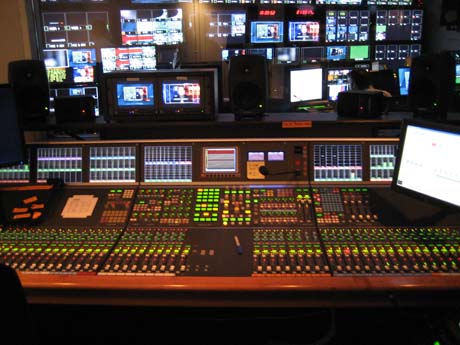|
Picture Lock
Picture lock is a stage in editing a film or editing a television production. It is the stage prior to online editing when all changes to the film or television program cut have been done and approved. It is then sent to subsequent stages in the process, such as online editing and audio mixing. Any last-minute changes can force portions of subsequent work to be redone. References Film and video terminology {{film-term-stub de:Picture lock ... [...More Info...] [...Related Items...] OR: [Wikipedia] [Google] [Baidu] |
Film Editing
Film editing is both a creative and a technical part of the post-production process of filmmaking. The term is derived from the traditional process of working with film stock, film which increasingly involves the use Digital cinema, of digital technology. When putting together some sort of video composition, typically, one would need a collection of shots and footages that vary from one another. The act of adjusting the shots someone has already taken, and turning them into something new is known as film editing. The film editor works with raw footage, selecting Shot (filmmaking), shots and combining them into Sequence (filmmaking), sequences which create a finished Film, motion picture. Film editing is described as an art or skill, the only art that is unique to cinema, separating filmmaking from other art forms that preceded it, although there are close parallels to the editing process in other art forms such as poetry and novel writing. Film editing is an extremely important ... [...More Info...] [...Related Items...] OR: [Wikipedia] [Google] [Baidu] |
Offline Editing
Offline editing is the creative storytelling stage of film and television production where the structure, mood, pacing and story of the final show are defined. Many versions and revisions are presented and considered at this stage until the edit gets to a stage known as picture lock. This is when the process then moves on to the next stages of post production known as online editing, colour grading and audio mixing. Typically, during offline editing, all the original camera footage (often tens or hundreds of hours) is digitized into a Non-Linear Editing System as a low resolution duplicate. The editor and director are then free to work with all the footage to create the final cut. Editing the copy allows multiple story and creative possibilities to be explored without affecting the camera original film stock or video tape. Once the project has been completely offline edited, the low resolution footage is replaced with the original high resolution media, or "brought online." Moder ... [...More Info...] [...Related Items...] OR: [Wikipedia] [Google] [Baidu] |
Online Editing (video Production)
Online editing is a post-production linear video editing process that is performed in the final stage of a video production. It occurs after offline editing. For the most part, online editing has been replaced by video editing software that operate on non-linear editing systems (NLE). High-end post-production companies still use the Offline-Online Editing workflow with NLEs. The term online originated in the telecommunication industry, meaning "''Under the direct control of another device''" (automation). Online editors such as the Sony BVE-9000 edit control unit used the RS-422 remote control 9-Pin Protocol to allow the computer-interface of edit controllers to control video tape recorders (VTR) via a series of commands. The protocol supports a variety of devices including one-inch reel-to-reel type C videotape as well as videocassette recorders (VCR) to Fast-Forward, Rewind and Play and Record based on SMPTE time-code. The controllers have the ability to interface with prof ... [...More Info...] [...Related Items...] OR: [Wikipedia] [Google] [Baidu] |
Audio Mixing (film And Television)
Audio mixing is the process by which multiple sounds are combined into one or more audio channels. In the process, a source's volume level, frequency content, dynamics, and panoramic position are manipulated or enhanced. This practical, aesthetic, or otherwise creative treatment is done in order to produce a finished version that is appealing to listeners. Audio mixing is practiced for music, film, television and live sound. The process is generally carried out by a mixing engineer operating a mixing console or digital audio workstation. Recorded music Before the introduction of multitrack recording, all the sounds and effects that were to be part of a recording were mixed together at one time during a live performance. If the sound blend was not satisfactory, or if one musician made a mistake, the selection had to be performed over until the desired balance and performance was obtained. However, with the introduction of multitrack recording, the production phase of a m ... [...More Info...] [...Related Items...] OR: [Wikipedia] [Google] [Baidu] |
Film And Video Terminology
A film, also known as a movie or motion picture, is a work of visual art that simulates experiences and otherwise communicates ideas, stories, perceptions, emotions, or atmosphere through the use of moving images that are generally, since the 1930s, synchronized with sound and (less commonly) other sensory stimulations. Etymology and alternative terms The name "film" originally referred to the thin layer of photochemical emulsion on the celluloid strip that used to be the actual medium for recording and displaying motion pictures. Many other terms exist for an individual motion-picture, including "picture", "picture show", "moving picture", "photoplay", and "flick". The most common term in the United States is "movie", while in Europe, "film" is preferred. Archaic terms include "animated pictures" and "animated photography". "Flick" is, in general a slang term, first recorded in 1926. It originates in the verb flicker, owing to the flickering appearance of early films ... [...More Info...] [...Related Items...] OR: [Wikipedia] [Google] [Baidu] |


